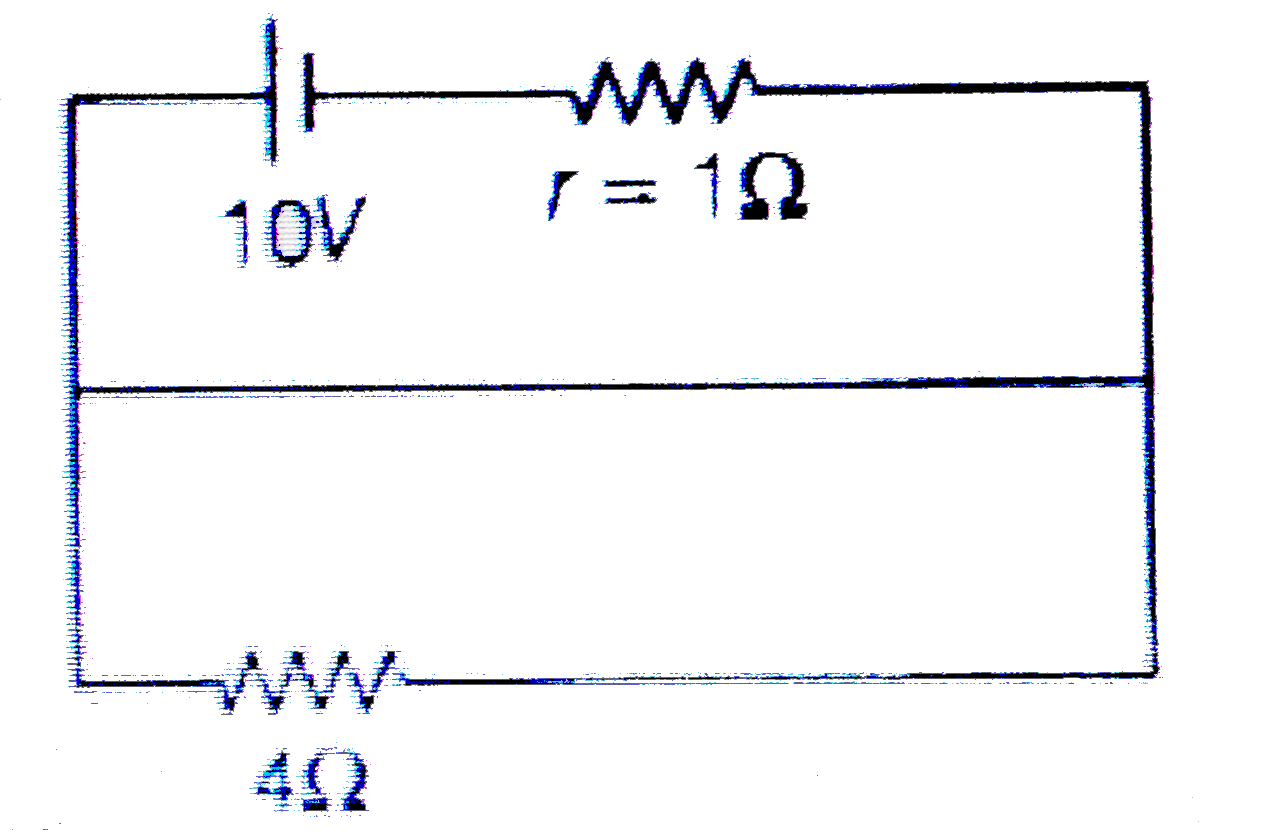The potential difference across the terminals of a battery is 8.4V when there is a current of 1.50A in the battery from the negative to the positive terminal. When the current is 3.50Air, the reverse direction, the potential difference becomes 9.4V.
(a) What is the internal resistance of the battery?
(b) What is the emf of the battery?
The correct Answer is:A, B
To solve the problem, we will use the concepts of internal resistance and electromotive force (emf) of the battery.
Given:
1. When current I1=1.50A (discharging), potential difference V1=8.4V.
2. When current I2=3.50A (charging), potential difference V2=9.4V.
(a) Finding the internal resistance of the battery:
1. Using the formula for discharging:
V1=E−I1R
Rearranging gives:
E=V1+I1R
Substituting the values:
E=8.4+1.5R(1)
2. Using the formula for charging:
V2=E+I2R
Rearranging gives:
E=V2−I2R
Substituting the values:
E=9.4−3.5R(2)
3. Equating the two expressions for E:
8.4+1.5R=9.4−3.5R
4. Solving for R:
8.4+1.5R+3.5R=9.4
5R=9.4−8.4
5R=1
R=15=0.2Ω
(b) Finding the emf of the battery:
1. Using the value of R in either equation (1) or (2):
Using equation (1):
E=8.4+1.5(0.2)
E=8.4+0.3
E=8.7V
Final Answers:
- (a) The internal resistance of the battery is R=0.2Ω.
- (b) The emf of the battery is E=8.7V.
1. When current I1=1.50A (discharging), potential difference V1=8.4V.
2. When current I2=3.50A (charging), potential difference V2=9.4V.
V1=E−I1R
Rearranging gives:
E=V1+I1R
Substituting the values:
E=8.4+1.5R(1)
V2=E+I2R
Rearranging gives:
E=V2−I2R
Substituting the values:
E=9.4−3.5R(2)
8.4+1.5R=9.4−3.5R
8.4+1.5R+3.5R=9.4
5R=9.4−8.4
5R=1
R=15=0.2Ω
Using equation (1):
E=8.4+1.5(0.2)
E=8.4+0.3
E=8.7V
- (a) The internal resistance of the battery is R=0.2Ω.
- (b) The emf of the battery is E=8.7V.
Topper's Solved these Questions
- CURRENT ELECTRICITYBOOK - DC PANDEY ENGLISHCHAPTER - CURRENT ELECTRICITYEXERCISE - Level 2 Single Correct
26 Videos
- CURRENT ELECTRICITYBOOK - DC PANDEY ENGLISHCHAPTER - CURRENT ELECTRICITYEXERCISE - Level 2 More Than One Correct
10 Videos
- CURRENT ELECTRICITYBOOK - DC PANDEY ENGLISHCHAPTER - CURRENT ELECTRICITYEXERCISE - OBJECTIVE_TYPE
1 Videos
- COMMUNICATION SYSTEMBOOK - DC PANDEY ENGLISHCHAPTER - COMMUNICATION SYSTEMEXERCISE - Subjective
11 Videos
- ELECTROMAGNETIC INDUCTIONBOOK - DC PANDEY ENGLISHCHAPTER - ELECTROMAGNETIC INDUCTIONEXERCISE - Medical entrances gallery
25 Videos
Similar Questions
The potential difference across the terminals of a battery is 10 V when there is a current of 3 A in the battery from the negative to the positive terminal. When the current is 2A in the reverse direction, the potential difference becomes 15 V. The internal resistance of the battery is
View SolutionPotential difference across the terminal of a non ideal battery is
View Solution
Knowledge Check
When a current of 2 A flows in a battery from negative to positive terminal, the potential difference across it is 12 V. If a current of 3 A flowing in the opposite direction produces a potential difference of 15 V, the emf of the battery is
A12.6VB13.2VC13.5VD14.0V
Potential different across the terminals of the battery shown in figure is

View SolutionThe potential difference between the terminals of a 6.0V battery is 7.2 V when it is being charged by a current of 2.0A.What is the internal resistance of the battery?
View SolutionThe potential difference between the terminals of an electric heater is 60V when it draws a current of 4A from the source. What current will the heater draw if the potential difference is increased to 120V ?
View SolutionThere identical point masses, each of mass 1 kg lie in the xy-plane at points (0, 0), (0, 0.2 m) and (0, 2m, 0). The net gravitational force on the mass at the origin is:
View SolutionWhen current supplied by a cell to a circuit is 0.3A, its terminal potential difference is 0.9 A. When the current supplied becomes 0.2 A, its terminal potential difference becomes 1.0 V . The internal resistance of the cell is
View SolutionA voltmeter reads the potential difference across the terminals of an old battery as 1.40V, while a potentiometer reads its voltage to be 1.55V. The voltmeter resistance is 280Ω.
View SolutionWhat is the current drawn from the battery of 6 V ?

View Solution
